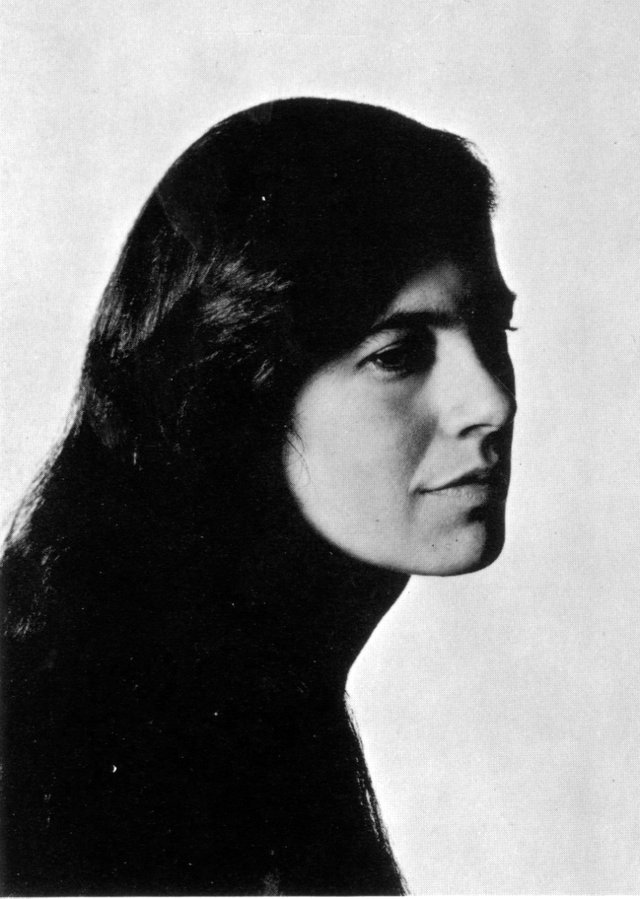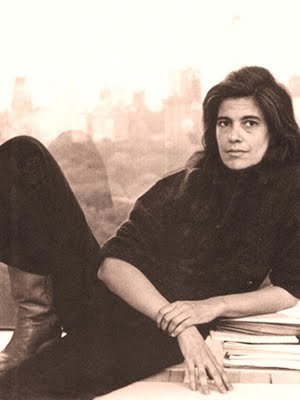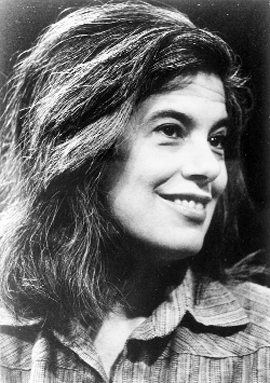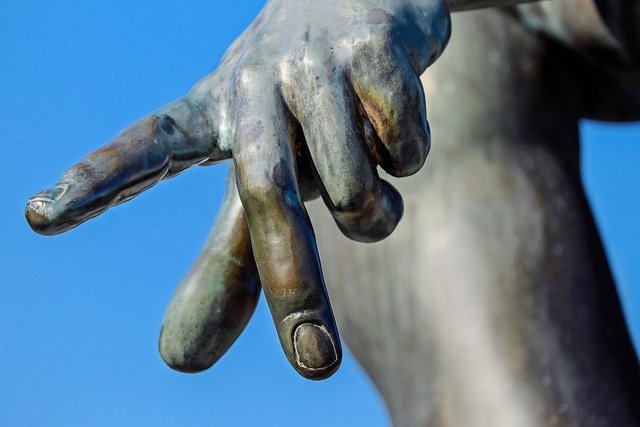On the Birthday of Literary Heroine, Susan Sontag, An Appreciation:

She lived up to her definition of a writer, someone who was interested in everything; and showed us how interesting she could be by writing intelligently on subjects as varied as philosophy and pornography. She was that rare sort of critic, whose appreciative faculty was as developed as her critical one. Rather than hectoring or tearing down, she preferred to communicate her enthusiasms or discoveries in an infectiously spirited style, always arguing on the side of sophistication.
At times her high brow interests could be vertiginous, prompting conservative critic Roger Kimball to pay her the backhanded compliment of cultivating a certain “altitude.” But she was as delighted by the contours and movement of the mind as she was of the body. Dance or art were just as likely the subjects of her admiring attentions as were her beloved European thinkers whom she introduced to an unsuspecting American audience. In the process she gradually altered prevailing aesthetic tastes and the shape of the intellectual landscape in favor of “a pluralistic, polymorphous culture.”
As a passionate thinker and self-appointed cultural provocateur, Sontag championed liberty of the mind and body and, indifferent to controversy, defended them against their hijackers at home or abroad. In opposition to the Vietnam War, following a trip to Hanoi, she stridently proclaimed that "the white race is the cancer of human history." (Later diagnosed with cancer, she reneged somewhat, saying that she had been unfair -- to cancer). When, in 1989, the Ayatollah Khomeini of Iran issued a fatwa against author Salman Rushdie for The Satanic Verses, Sontag (then president of PEN American Center, an international organization of writers) denounced it as “an act of terrorism against the life of the mind.”

Controversially, in an incendiary New Yorker article addressing the September 11, 2001 attacks, Sontag refused to refer to the attackers as cowards since courage, she argued, is a morally neutral term. This "monstrous dose of reality" was an attack on the world’s self-proclaimed superpower (read bully) and thus a consequence of specific American alliances and actions. This did not make her popular in the stunned and confused post 9/11 USA. Following the article, she received death threats along with calls for her to relinquish her US citizenship. Yet as a philosopher, Sontag was a citizen of no community. Her allegiances were always larger than any nation state, while her loyalties were to humanity and the truth as she saw it.
In her spartan New York City apartment, Sontag owned a small clock that told time in America on one side and Europe on the other. Like her clock, Sontag had a foot in America and another in Europe, straddling cultures. She lived for long periods in France and Italy and was versed in both tongues. A self-confessed Europhile, she immersed herself in European criticism and cinema as well as its history of ideas, seeking to overcome the limitations of her own culture in herself. She was a ‘public intellectual’ in the French tradition: engaged, political and outspoken. Yet for all her conscientious involvement on the public stage, she discreetly guarded her personal life: “I don’t talk about my erotic life any more than I talk about my spiritual life,” she once told a journalist, “. . . it always ends up sounding so banal.”
Sontag enjoyed what she termed "probably the best university education in the planet." At sixteen, having outstripped her teachers (her high-school principal’s words), she was shuttled off to Berkley. From there the wunderkind transferred to Chicago University then on to Harvard, where she became engrossed in philosophy and comparative religions. Later at Oxford, she came under the influence of her teacher, novelist and philosopher Iris Murdoch, capping her prestigious international education with a spell at the Sorbonne.
A precocious and voracious reader, Susan Sontag turned to books in her childhood “to ward off the jovial claptrap of classmates and teachers, the maddening bromides I heard at home.” As an adult, she would continue to extol the pleasures of the text and its spiritual edification. Reading, “that disembodied rapture . . . is trance-like enough to make us ‘feel’ egoless,” she confessed in an essay “Writing as Reading” (2000). While writing was merely an extension of this beloved pastime, as she says in that same essay, “to write is to practice, with particular intensity and attentiveness, the art of reading.”

In a 1995 essay, “Singleness,” Sontag articulates her passion for literature, thus: “Admiration -- no, veneration -- for a host of books had brought me to my vocation, on my knees.” Her Borgesian library is a living testament to her relentless self-education and enduring devotion. Composed of 15,000 books, catalogued by subject and language (not alphabetically), she referred to her library-dominated apartment as “the inside of my head . . . (and) a map of my brain.” Moreover, her intimate and reverent dialogue with her literary heroes was undeterred by death. In an open letter to Borges penned a decade after his passing, she writes affectingly: “It does not seem odd to be writing you . . . since you always wrote under the sign of Eternity.”
As an essayist she stood apart from her contemporaries. Her best essays bear comparison with that premiere essayist, Montaigne, for their acuity and wit; as well as successfully using the format to interrogate and discover herself, while testing the limits of her indefatigable responsiveness. On account of these miniature marvels, many first appearing in the New York Review of Books, she was declared a new star in the cultural skies of the 1960s. Since then, Sontag came to be regarded as a thinker of omnivorous appetite, writing in a dazzling aphoristic style that was still accessible to an educated general audience. With her dense academic knowledge, she trained her eyes and agile mind on the new: avante garde, modernism and the latest in French thought (Barthes, Artaud, Baudrillard).
As an amalgam of scholar and aesthete, she managed to forge a new style, the essay as performance art; and was credited with introducing a new sensibility, equally concerned with aesthetics as ethics -- most famously on display in her reputation-establishing essay “Notes on Camp.” For the 30 year anniversary of her seminal book of essays, Against Interpretation, she would ironically refer to herself in a new preface as a “pugnacious aesthete . . . and a barely closeted moralist.’ As for the new sensibility she was credited with, she modestly attributed that to her spiritual ancestors. “I was -- I believed -- merely extending to some new material the aesthete’s point of view I had embraced as a young student of philosophy and literature, in the writings of Nietzsche, Pater (and) Wilde.”

Equally conversant in all the arts, her constellation of interests encompassed science fiction, music, theatre, and the quandaries of translation. Photography was a profound and lifelong meditation, especially the extent to which a photograph could capture and transmit the truth. The appalling torture images of Abu Ghraib prison were an opportunity for Sontag, the theorist and activist, to reflect and speak out on the complex impact of photographs in her classic 2004 New York Times article entitled "On Photography." Refusing to settle for being an academic, Susan Sontag had become the median link between the world of academe and popular culture.
In Against Interpretation, perhaps exasperated with her own hyper-developed intellectual apparatus, she defended the senses against the intellect. Accordingly, “Interpretation was the evenge of intellect upon art . . . (and) the world.” Instead, Sontag exalted altered states of perception --intuition, ecstasy and dreams -- since sanity was but “a cozy lie” and art “a new kind of instrument . . . for modifying consciousness.”
Surprisingly, the essays that she seemed to fire off effortlessly did not come easily to her. Edmund White relates how Sontag once told him, "You know my essays are much more intelligent than I am . . . I rewrite them so many times, and slowly, slowly, I nudge them up the hill.” Unprolific, in the sense of having produced only 6 volumes of essays in over three decades, she would admit she slaved over an essay of a few thousand words for up to nine months. Author Mark Simpson appears to intuit this in his review of her magisterial book of essays: Where the Stress Falls. “Her impressive, swan-like prose always inclines me at least to wonder how much furious peddling is going on beneath the water line.”

In 1976, Sontag was diagnosed with cancer and told she was not expected to live more than two years. Applying her radical will, and enduring radically high doses of chemotherapy for the next two and a half years, she put to practice the prayer of lifelong invalid and precursor of Existentialism, Pascal: “Teach us the proper use of sickness.” By stoically becoming a student of her own condition and exercising her own facility for metaphor, Sontag produced a book. Although certainly ‘informed’ by her experience, Illness as Metaphor does not discuss her illness specifically but the stigma of sickness in general. Much later, reflecting on these harrowing years, Sontag would say: If you think you are going to die, and you are spared . . . you always feel a little posthumous.”
Susan Sontag actually died of leukemia on December 28, 2004 at the age of 71. In an influential and illustrious career spanning over four decades she has been called everything from “the thinking man’s pin-up” to “the high priestess of the American avant-garde”, and “the Last Intellectual.” Eminent Mexican writer Carlos Fuentes compared Ms. Sontag to the Renaissance humanist Erasmus. "Erasmus traveled with 32 volumes, which contained all the knowledge worth knowing. Susan Sontag carries it in her brain! I know of no other intellectual who is so clear-minded, with a capacity to link, to connect, to relate."
Throughout an honorable life marked by unusual curiosity, commitment and courage, Sontag succeeded in securing the attention and recognition of the world (with her books being translated into thirty-two languages). At 70, she received one of the German-speaking world's most prestigious literary prizes, 2003 Peace Prize of the German Book Trade, for acting as ‘intellectual ambassador’ between the United States and Europe. In 2001, she won Israel's top literary award, the Jerusalem Prize, where she dared to use the occasion to criticize Israeli policy: “There can be no peace here until the planting of Israeli communities in the territories is halted.” Her historical novel, In America, garnered the National Book Award in 2000 and, in 1999, she was named a Commandeur de l’Ordre des Arts et des Lettres by the French government. The list is long, but it goes on.
Revisiting her pet subject of photography in a 1985 essay, “Certain Mapplethorpes,’’ Sontag articulates the inadequacy of the medium thus: "The photograph comes as a kind of reproof to the grandiosity of consciousness.” In pursuing literature, her aim was antithetical, namely to expand consciousness. Having conceived of literature as a calling and a noble project she strove to honor all her life, Sontag’s ardently expressed rallying cry remained: "Be serious, be passionate, wake up!"

© Yahia Lababidi
A version of this essay appeared in Arts & Opinion: http://www.artsandopinion.com/2009_v8_n5/labadidi-sontag.htm
(Images of Sontag: https://elvuelodelalechuza.com/2016/08/19/susan-sontag-filosofia-de-la-fotografia/
Other images: Pixabay)